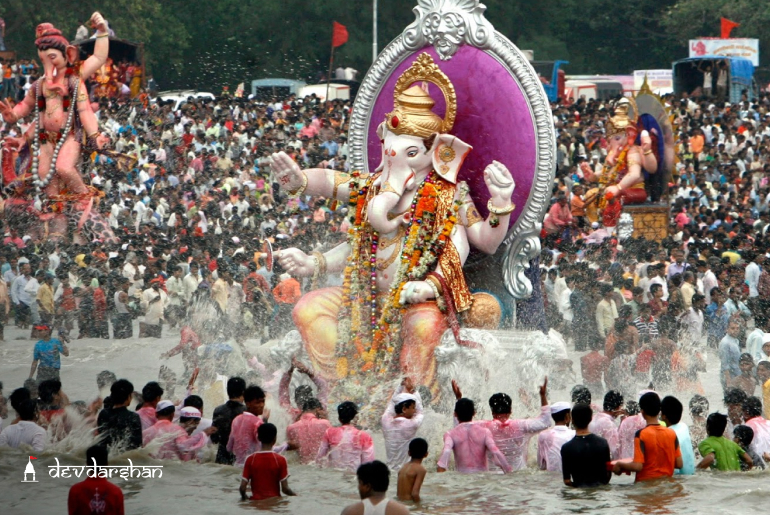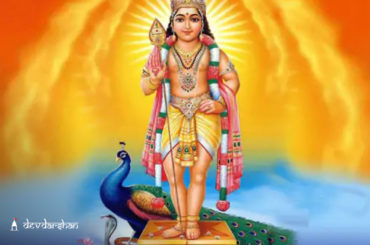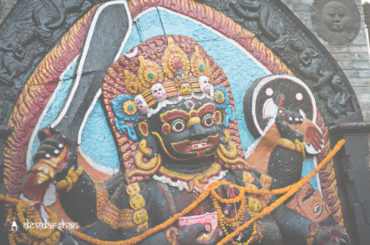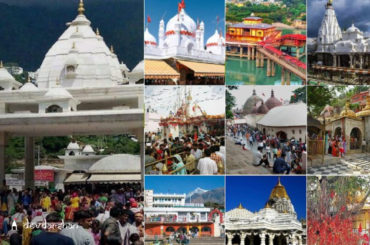Ganpati Visarjan 2023 is celebrated with great pomp and show in India. Thousands of people participate in this festival. On the day of Ganesh Chaturthi, devotees install the idol of Lord Ganesha in their homes and perform worship and rituals for 10 days. After that, on the day of Anant Chaturthi, the immersion of Lord Ganesha takes place, which is widely celebrated as Ganpati Visarjan.
During the festival, Devotees bring the idol of Lord Ganesha to their homes and take care of him like a child. They perform puja, offer prayers and serve him, but also immerse the idol of Lord Ganesha in nearby lakes, ponds or rivers. Have you ever wondered why Ganesh Visarjan is performed at the end of the festival? Let’s explore the mythological story behind it as well as its date, muhurat and significance.
Also Read: How to Observe Chaturthi Vrat?
So, let’s get to know more about the Date, Rituals and Significance of Ganesh Visarjan 2023.
Ganesh Visarjan 2023: Date, Muhurat and Timings
This year, Ganesh Visarjan will start on Thursday, September 28, 2023
- Chaturdashi Tithi Begins – 11:48 p.m on September 27, 2023
- Chaturdashi Tithi Ends – 08:19 p.m on September 28, 2023
Visarjan Muhurat
- Morning Muhurat (Shubha): 06:09 a.m to 07:39 a.m
- Morning Muhurat (Chara, Labha, Amrita): 10:40 a.m to 03:11 p.m
- Afternoon Muhurat (Shubha): 04:41 p.m to 06:11 p.m
- Evening Muhurat (Amrita, Chara): 06:11 p.m to 09:11 p.m
- Night Muhurat (Labha): 12:10 a.m to 01:40 a.m, September 29
Also, Find the Date and Muhurat of Ganesh Sthapana on Ganesh Chaturthi
Significance of Ganesh Visarjan
In Hinduism, Lord Ganesha is considered the deity of intellect, speech, and wisdom. That is why Lord Ganesha is invoked first in any auspicious event. Only after that, the worship of other deities takes place. According to mythological beliefs, worshipping Lord Ganesha removes all obstacles in life. It is also believed that Lord Ganesha was born on the fourth day of the bright half of the Bhadrapada month. That is why on the day of Ganesh Chaturthi, Lord Ganesha is installed in every household and worshipped for 10 days. On the day of Anant Chaturdashi, the idol of Lord Ganesha is immersed in a river or a pond, seeking his blessings.
Moreover, during Ganesha Visarjan, it is believed that Lord Ganesha, along with his parents, Lord Shiva and Goddess Parvati, makes a spiritual journey from Mount Kailash to be reunited with them. This sacred occasion holds great significance as it commemorates the transition of Lord Ganesha from his physical form to his formless, spiritual essence. It is a unique festival in Hinduism that honours both the tangible and intangible aspects of the Supreme Being.
Ganesha Visarjan serves as a reminder of the transient nature of life and the importance of the cycle of birth, existence, and passing away. As the deity associated with new beginnings, Lord Ganesha is venerated for his ability to remove obstacles and pave the way for success. During the Visarjan ritual, it is believed that Lord Ganesha takes away all the challenges and obstacles faced by the household and the family.
This festival holds immense significance and is eagerly anticipated by Devotees from all walks of life, making it one of the most widely celebrated and cherished occasions in society. It is a time to honour and celebrate the divine nature of Lord Ganesha and seek his blessings for a prosperous and obstacle-free future.
Also Read: Significance of Pitru Shradh and Rituals to Follow
Ganesh Visarjan 2023 Rites and Rituals
Ganesha Visarjan, the concluding ritual of the ten-day festival of Ganesh Chaturthi, symbolizes the departure of Lord Ganesha from the mortal realm back to his divine abode. Here is a step-by-step guide on how to perform Ganesha Visarjan on the final day of Ganesh Chaturthi.
- Begin the day by performing the morning puja as usual. Offer your prayers and seek blessings from Lord Ganesha.
- Adorn the idol of Lord Ganesha with flowers, garlands, and other decorative items using eco-friendly materials before the visarjan.
- While carrying the idol for immersion, chanting devotional songs and mantras such as “Ganpati Bappa Morya” and “Om Gan Ganpataye Namah.”
- Before immersing the idol, perform the final aarti, a ceremonial waving of lights, and seek blessings from Lord Ganesha.
- Proceed in a procession towards the water body with the idol, accompanied by the beats of drums, bells, and other musical instruments.
- Upon reaching the water body, immerse the idol of Lord Ganesha in the water while reciting prayers and mantras.
- After the immersion, offer final prayers and seek blessings from Lord Ganesha, acknowledging his return to his divine realm.
- As a concluding celebration, prepare a feast and share it with family and friends, signifying the end of the festival.
By following these rituals, devotees bid farewell to Lord Ganesha with gratitude, love, and the hope of his auspicious presence in their lives until his return in the following year’s Ganesh Chaturthi.
Also Read: FIVE Powerful Ganesh Mantras to Attract Overall Well-Being and Growth
Mythological Legends Behind Ganesh Visarajan
According to the Puranas, Maharishi Ved Vyasa invited Lord Ganesha to transcribe the Mahabharata. Lord Ganesha accepted his request but placed a condition that ‘Once I start writing, I will not stop the pen. If the pen stops, I will cease writing’. Vyasa agreed to this condition. With his eyes closed, Vyasa began narrating the Mahabharata, and Lord Ganesha transcribed it without pausing. After 10 days, when the Mahabharata was complete, Vyasa noticed that Lord Ganesha’s temperature had risen significantly. To cool him down, Vyasa immersed Lord Ganesha in water. Since then, the tradition of Ganapati Visarjan (immersion) has been practised.
History Behind Ganesh Chaturthi and Ganesh Visarjan
In the 18th century, Shivaji introduced grand celebrations for Vinayagar Chaturthi. During this time, in the city of Pune, which was under the rule of the Peshwas, public celebrations began taking place during the Bhadrapada month.
However, these celebrations were limited to private homes during the period of British rule.
In 1893, Bal Gangadhar Tilak revived the tradition of community celebrations in order to foster collaboration among freedom fighters and strategize against the British. These community celebrations were known as Sarvajanik Utsav. Tilak aimed to bring together people from different castes, including Brahmins and non-Brahmins, under the guise of these festivities.
During the 18th and 19th centuries, the idols of Lord Ganesha were created and immersed on the same day, every day, for a whole month. This was accompanied by feasts and festive activities for the community. Over time, while some continued with the month-long ritual, wealthier families opted to keep the idol for 1.5, 3, 5, or 10 days.
DevDarshan
Check out various Online Puja and services provided by DevDarshan here and get your bookings done in one click. If you want to know more about Indian culture, Indian Temples, Pujas and festivals, then download the DevDarshan App. Don’t forget to share this blog if you liked.





